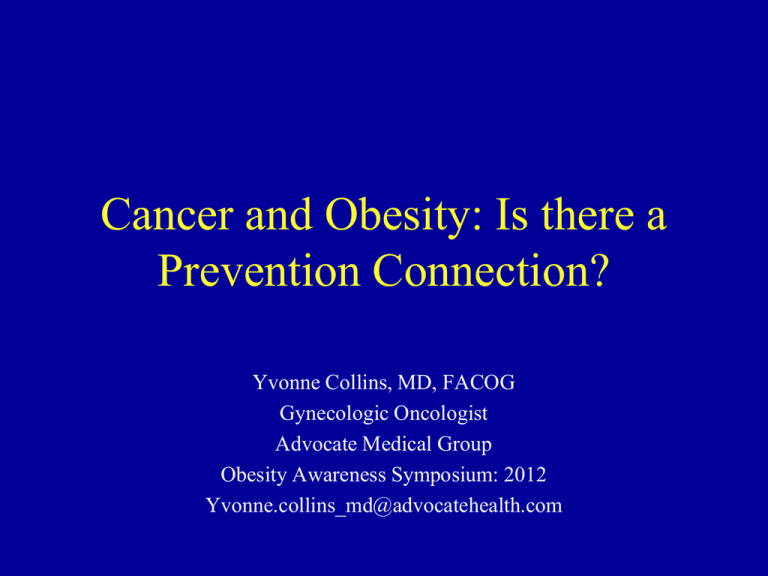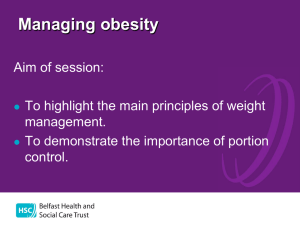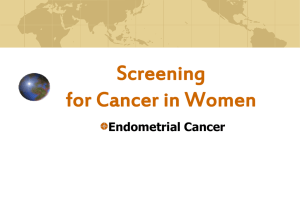
Cancer and Obesity: Is there a
Prevention Connection?
Yvonne Collins, MD, FACOG
Gynecologic Oncologist
Advocate Medical Group
Obesity Awareness Symposium: 2012
Yvonne.collins_md@advocatehealth.com
Disclosure
• I have no relevant conflicts of interest
I think this is hilarious! I
NEVER HEARD
CREATION EXPLAINED
THIS WAY BEFORE !!!
Objectives
• Review obesity statistics
• Review cancers directly associated with
obesity
• Discuss mechanisms of obesity and cancer
• Discuss the health outcomes related to
weight control and weight cancer
• Explain obesity reduction efforts
Prevalence of Obesity
• Greater than two thirds of US adults were
overweight or obese by 2000
• About 25% of Americans are obese as
defined by a BMI of 30 > kg/M2 301.6 million
people world wide are obese
• Significant health risks are related to obesity
Obesity Trends* Among U.S. Adults
BRFSS, 1990, 2000, 2010
(*BMI 30, or about 30 lbs. overweight for 5’4” person)
2000
1990
2010
No Data
<10%
10%–14%
15%–19%
20%–24%
25%–29%
≥30%
Obesity no longer limited to
the US
• 1.6 billion people world wide are at least
overweight
• Almost 25% of people in the UK are
overweight or obese.
• Even Asian countries are noticing and
increase
• One can be obese yet malnourished
How is Obesity Assessed?
• BMI
• Weight
– Weight in earlier life
– Adult weight gain
•
•
•
•
Waist circumference; WHR
Skin folds
Body fat (DXA, BIA)
Intramuscular fat (CT scan)
Background
By 2020, 75% of the US will be overweight
OECD Report, September 2010
Body Fatness,
and the Risk of Cancer
AICR/WCRF 2007
Background
Fair AM, Montgomery K. Methods Mol Biol. 2009;472:57-88.
Impact Factors
Candidate Mechanisms
• Insulin and insulin like growth factor
axis
• Sex steroids
• Adipokines
• Obesity induced hypoxia
• Shared genetic susceptibility
• Migrating adipose stromal cells
High Insulin Levels are an
adverse prognostic factor
associated with:
• Breast cancer
• Colon cancer
• Prostate cancer
Sex Hormones
• Higher rates of conversion of
androgenic precursors to estradiol
• Increased aromatase activity through
adipose tissue
• Data indicates that estrogen is both
mitogenic and mutagenic
Endogenous Hormones and
Breast Cancer Collaborative
Group (EHBCCG)
• Nine prospective studies
• Risk of breast cancer increases at least two fold with
increased levels of sex steroids
– DHEA
– DHEAS
– Androstendione
– Estrone
– Estradiol
– Testsosterone
Estrogen stimulation in
endometrial cancer
•
•
•
•
Increases cellular proliferation
Inhibits apoptosis
Induces synthesis of IGF-1
Progesterone induces synthesis of
IGFBP-I which inhibits IGF-I
Effect of obesity on hormones
Obesity, Hormones and
Endometrial Cancer
Leptin
• Leptin deficient mice overfeed and
rapidly become hyperinsulinemic
• Long arm of leptin receptor (LRb)
activates
– PI3 kinase
– MAPK
– STAT (signal transduce and activator
transcription)
– C-fos
Adiponectin
• Most abundant adipokine
• Important insulin sensitizing agent
• Inverse association of adiponecitn
concentrations and cancer
• Antiproliferative effects
–
–
–
–
ERK
ERK1
MAPK kinases
Induces p53 and Bax
Obesity Related Hypoxia
• Adipose tissue hypoxia is a key factor in the
development of insulin resistance
• Regulation of chronic inflammation
• Reduced adiponectin
• Increased leptin
• High levels of tumor hypoxia correlate with
high mortality
• HIF-1 alpha is associated with poor prognosis
Obesity related hypoxia
• White adipose tissue in obese mice is
more hypoxic than in lean mice (15.2
mmHg versus 47.9 mmHg
– Ye et al Am J Phys. Endo Met 2007
• Low oxygen concentrations have been
associated with stimulation of
melanocytes and development of
melanoma
– Through the AKT, ras/raf, PI-3-Kinase pathways
– Bedogni Cancer Cell 2005
Shared Genetic Susceptibility
• Genome wide studies show at least 15
loci associated with obesity
• Cancer genome maps are derived from
a number of parallel genome wide
associated regions
• Overlap may exist for breast on 11p and
16q
– Hofker et al Nat Genetic 2009
Obesity related inflammatory
markers
• Increased C-reactive protein
• Activation of c-Jun NH2-terminal kinase
• Activation of IkB kinase beta increases with
adiposity
• Increased activated macrophage infiltration
– Now recognized as a mechanism of insulin
resistance
Mechanical Markers
• Hypertension
• Acid reflux
• Increased iodine uptake
Breast Cancer
• Increased postmenopausal breast cancer
• Decreased premenopausal cancer
• Increased weight gain 18-50 increases risk
of breast cancer after menopause
Colon Cancer
• For men, increased BMI = increased risk
• The strongest association with abdominal
obesity (waist circumference)
• Also, increased BMI is associated with
rectal cancer
Esophageal Cancer
• Esophageal adenocarcinoma is 2X’s higher
in those who are overweight and obese
• Associated link with gastroesophageal
reflux and Barrett’s esophagus
• Obesity exacerbates esophageal
inflammation
Prostate Cancer
• Pooled data: obesity is associated with a
slight increased risk
• Obese men have more aggressive cancers
• Linked to hormone and growth factors (esp
IGF-1
Other Cancers
• Obesity is associated with renal cell cancer
– Related to high insulin levels
• Associated with thyroid cancer
– Mechanism is unknown
• Associated with gallbladder cancer
– Possible mechanism related to frequency of
gallstones
So what do we know thus far
related to GYN cancers?
• Obesity is NOT clearly associated
with:
– Vaginal cancer
– Vulvar cancer
• Obesity is possibly associated
with:
– Cervical Cancer
– Ovarian cancer -premenopausal
Obesity and Adult Weight Gain
• Strongly associated with
endometrial cancer
Endometrial Cancer
• Most common gynecologic cancer
• We perceive it to be associated with
obesity
• Increasing incidence
• Hormone related cancer
Obesity
• Strongest risk factor for endometrial cancer1
– RR 4.0 - BMI>32 kg/m2
– RR 6.0 - BMI>35 kg/m2
• Elevated endogenous estrogens
• “Hyper-estrogenic” state does not account
for all cases2
• Other obesity-related factors may contribute
to increased risk for endometrial cancer
1Brinton
et al. Am J Obstet Gynecol
1992
2Potishman et al. JNCI 1996
Progression of the Endometrium to Cancer
Normal
•
•
•
Complex atypical
hyperplasia (CAH)
Grade 1
Endometrial
cancer
23% of complex atypical hyperplasia (CAH) progresses to
endometrial cancer
Excess of estrogen and lack of progesterone causes
abnormal proliferative drive
Subset of aggressive histologies that do not follow this
progression pathway
Endometrial Cancer: Annual Incidence and
Mortality
ACS Estimates
Year
Cases
Deaths
1987
35,000
2,900
2008
40,100
7,170*
*250% increase
American Cancer Society 2008
Goal: Prevention of deaths
40,000+ cases
34,000
28,800
5,200
7,000+ deaths
endometrioid
G1-2
G3
4,000
UPSC
1,200
Clear Cell
800 Sarcoma/CarcinoSarc
3,710
1,820
How do
1,890 we
2,800
560
400
identify
these
patients
and
prevent
death?
Background
OBESITY
Estrogen
Insulin
Adipokines
Healthy
Endometrium
Diet
Exercise
Hormone therapy
Chemoprevention
Complex
Atypical Hyperplasia
&
Endometrial
Adenocarcinoma
Prevention of Obesityassociated Endometrial
cancer
•
•
•
•
•
Oral contraceptives
Progestins (including IUD w/Progestin)
Weight loss
Bariatric surgery
? Metformin
Implications
Employment/ Support system/ Cancer therapies
Fatigue
Intake
Caffeine, sugar
Lifestyle
Interventions
diet, physical
activity,
weight, sleep,
etc.
Changing hormonal
environment
↓ Hormones and activity
↓
↓ Metabolic
Muscl
Rate
↓ Energy
e
Needs
Reversal
Mass
or
Primary
Reduced
QOL
prevention
Increased
Mortality
Improved QOL
Weight control
Poor
Slee
p
Weight Gain,
Reduced physical
function
Co-morbidity
Implications:
Obesity- related Co-morbidity
•
•
•
•
•
Cardiovascular
Neurologic
Psychiatric
Pulmonary
Vascular
•
•
•
•
Gastrointestinal
Genitourinary
Metabolic
Musculoskeletal
Taking care of patients can be
extremely challenging…
Modesitt, Obstet Gyn Survey, 2005
Opportunities
• Prevention of weight gain during
adolescence and early adulthood
– Weight trajectory “mapping”
• Monitor for central adiposity
– Waist circumference
• Monitor for risk of obesity-related disease
– Metabolic syndrome
• Intervene early if weight increases
• Do not under-estimate the role of
Therapy:
Don’t wait, Don’t hesitate
• Cancer diagnosis is an
opportunity for behavior
change
• Support systems are active
• Consequences (risk vs
benefit) are high
• Engage healthcare team
• Small changes can translate
to significant improvements
in health indices and greater
health and well-being
Questions?
GOG-225
Can Diet and Physical Activity
Modulate Ovarian Cancer
Progression Free Survival?
Schema-GOG-225
Ovarian Cancer
Diagnosis:
Successful first
line treatment
consolidation
R
A
N
D
O
M
I
Z
E
1:1
intervention:
comparison
Comparison
Lifestyle
Intervention Lifestyle:
7 servings of vegetables
and fruit , low fat (<
20%)
+ 4000 additional steps
daily (weight control)
Progressionfree survival
(@ 2 years)
Primary Objective
• Determine if disease-free women who
completed therapy for Stage II-IV
ovarian, fallopian tube or primary
peritoneal cancer randomized to a
healthy lifestyle intervention have
increased progression free survival
compared to those randomized to usual
care
Status
• Protocol approved
• Sites processing Human Subjects
approvals
• Recruitment / active enrollment
• Estimate 20 new enrollees monthly
Summary
• BMI associated with cancers
• Obesity is a complex system –no on
size fits all
• Bariatrics (less obesity related cancers)
• Prevention methods include
– Exercise
– Weight loss
– Diet control
Opportunities
• Cancer prevention
• Much needed research
– MD Anderson endometrial SPORE
• TREC (Transdisciplinary Reseach on
Energetics and Cancer)
–
–
–
–
–
Washington University
University California San Diego
Harvard University
University of Pennsylvania
University of Washington
References
THANKS!!!!











